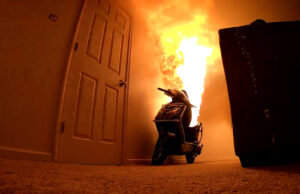This Holiday Season, Batteries Matter. Here’s Why.
If you’re buying rechargeable gadgets this holiday season, help protect family and friends on your gift list from potential fire hazards posed by the lithium-ion batteries that likely power them.

Lithium-ion batteries are often found in a multitude of everyday items — from e-bikes and cell phones to electronic toys and portable gaming devices. And everyday use has led to an increase in reoccurring dangers, from explosions and fires to electric shock: More than 1,500 incidents have been reported in 2023 — translating into 621 injuries and 111 fatalities, according to UL Solutions data.
The UL enterprise, which encompasses UL Research Institutes (ULRI), UL Standards & Engagement, and UL Solutions, has a long history of exploring how to make products with lithium-ion batteries safer — researching topics like counterfeit batteries, safe charging, and disposal of lithium-ion batteries and standard setting and testing for the products that contain them.
Our collective efforts have translated into numerous findings you can now use to protect yourself and others when buying lithium-ion powered products this holiday season.
Top holiday gifts containing lithium-ion batteries and a potential fire risk
According to an October 2023 study from UL Standards & Engagement, more than 2,000 U.S. consumers said they intend to purchase the following rechargeable gifts this holiday season:
- Electronic toys (29%)
- Wireless or Bluetooth headphones (27%)
- Small kitchen appliances (26%)
- Personal care and wellness products (23%)
- Smartphones (22%)
- Portable speakers, game controllers, tablets (18%)
- Portable charger/power banks (17%)
- Smartwatches and laptops (16%)
- Battery-powered power tools (15%)
- Portable gaming consoles (14%)
*More than one answer was allowed
Despite the commonality of these rechargeable electronics, consumers are mostly unaware they contain lithium-ion batteries and run the risk of thermal runaway — a state of uncontrollable heat that can result in fire or explosion if the battery is damaged, overcharged, or defective.
Looking for an easy-to-understand explanation of thermal runaway for kids? Check out this learning module from the Office of Research Experiences and Education.
Lack of awareness around battery safety poses risks
According to an August 2023 poll from UL Standards & Engagement on lithium-ion batteries, 36% of Americans said they were unaware smartphones, laptops, tablets, and e-readers contain these batteries. Much higher percentages were unaware of other top gifts that rely on their rechargeable power.
In fact, the majority of Americans did not realize lithium-ion batteries exist in:
- Small kitchen appliances like some cordless hand mixers and food choppers (83% unaware)
- Wireless headphones (70% unaware)
- Portable speakers (68% unaware)
- Game controllers (65% unaware)
- Smart watches (56% unaware)
Further, 44% of Americans did not know lithium-ion batteries had a thermal runaway risk at all, even though such incidents have increased in recent years. This awareness gap can be a safety threat to the very people who are receiving these rechargeable gifts.
When does lithium-ion battery safety matter most?
When you buy: Many of the safety hazards associated with rechargeable devices stem from products or batteries that do not come from a trusted retailer or manufacturer. Their quality, durability, and safety are often questionable.
- Know what kind of battery is in the device you plan to buy
- Always order batteries and chargers directly from the manufacturer of the device you need it for
- Make sure the products you’re buying comply with national safety requirements
Learn how to “Know Your Battery” to avoid fake products and buy batteries safely from the Electrochemical Safety Research Institute.
When you charge: Once you own a rechargeable device, charging and storing it with caution is critical to minimizing fire risks, especially since you may have less than a minute to escape the blazes of fast-burning lithium-ion battery fires.
- Charge with cables that came with the product or came directly from the manufacturer, and are certified by a third party
- Do not overcharge or charge devices overnight when a fire could ignite while people are sleeping
- Ensure lithium-ion powered devices are not blocking your exits in the event of a fire; store larger devices like e-bikes outside of your home if possible
- Store batteries away from extreme temperatures, direct sunlight, and anything flammable
Learn to “Take C.H.A.R.G.E.” of battery safety and fire prevention from the Fire Safety Research Institute.
When you dispose: Just as rechargeable devices or lithium-ion batteries can catch fire in a home or office, they can also catch fire in a dumpster or at waste sites and recycling centers. These fires are just as problematic, which is in part why recycling these devices is so important.
- Dispose of old or damaged batteries by taking them to the nearest battery recycling center
- Never discard batteries, chargers, or battery-powered devices in regular trash bins
- Additionally, materials inside lithium-ion batteries can be safely extracted and reused when properly recycled — contributing to a more sustainable society
“Be Nice To Your Device” so we can take advantage of the enormous potential lithium-ion batteries hold for a more sustainable future if they’re recycled safely.
Lithium-ion battery research
To address the growing challenges posed by lithium-ion batteries, ULRI has a multitude of research projects underway to evaluate their safety — from extraction and manufacturing to transport and proper disposal.
Learn more about the wide range of scientific research we do on a multitude of topics to help make the world a safer place.
PUBLISHED









